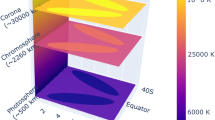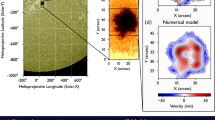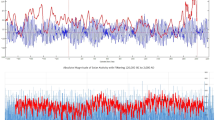Abstract
The cause of sunspots has long been an important, unsettled problem in solar physics. Biermann1 suggested that the strong magnetic field of a sunspot inhibited convection, allowing the sunspot to cool. Parker2, on the other hand, proposed that a sunspot was cooled by the generation of waves that carried away the thermal energy. The solar ‘constant’ has been measured with a daily uncertainty of about 10 parts per million (p.p.m.) by the Active Cavity Radiometer Irradiance Monitor (ACRIM) on board the Solar Maximum Mission (SMM) satellite launched in February 1980. The ACRIM has shown that the solar constant changes with solar activity, showing dips of the order of 0.1–0.3% associated with sunspots. This discovery has provoked renewed attempts to understand the sunspot phenomenon. Two divergent views are emerging: that the missing energy is stored in the convection zone for long periods of time3 or that the missing energy is re-radiated fairly quickly at different angles by faculae4, non-spot magnetic fields that often accompany sunspots. The consequences are that in the first case an 11-yr modulation is expected in the solar output whereas in the second case it is not. I point out here that facular emission may equal the missing energy from sunspots, over a period of some weeks or months, suggesting that the missing energy is stored by being converted from kinetic into magnetic energy after which it decays back into thermal energy in the faculae.
This is a preview of subscription content, access via your institution
Access options
Subscribe to this journal
Receive 51 print issues and online access
$199.00 per year
only $3.90 per issue
Buy this article
- Purchase on Springer Link
- Instant access to full article PDF
Prices may be subject to local taxes which are calculated during checkout
Similar content being viewed by others
References
Biermann, L. Vierteljahrsschr. astr. Ges. 76, 194 (1941).
Parker, E. N. Sol. Phys. 36, 249–274 (1974).
Eddy, J. A., Gilliland, R. L. & Hoyt, D. V. Nature 300, 689–693 (1982).
Oster, L., Schatten, K. H. & Sofia, S. Astrophys. J. 256, 768–773 (1982).
Willson, R. C. et al. Science 211, 700–702 (1981).
Chapman, G. A. Astrophys. J. Lett. 242, L45–L48 (1980).
Allen, C. W. Astrophysical Quantities 3rd edn (Athlone, London, 1973).
Foukal, P. V. in The Physics of Sunspots (eds Cram, L. E. & Thomas, J. H.) 391–423 (Sacramento Peak Observatory, Sunspot, 1981).
Harvey, J. in Workshop on Solar Irradiance Variations on Active Region Time Scales Pasadena (eds La Bonte, B., Chapman, G. A., Hudson, H. S. & Willson, R. C. (NASA Conference Proceedings, Washington DC, in the press).
Chapman, G. A. in Solar Active Regions (ed. Orrall, F. Q.) 43–82 (Colorado Associated University Press, Boulder, 1981).
Foukal, P. & Vernazza, J. Astrophys. J. 234, 707–715 (1979).
Dearborn, D. S. P. & Blake, J. B. Astrophys. J. 237, 616–619 (1980).
Wilson, P. R. in The Physics of Sunspots (eds Cram, L. E. & Thomas, J. H.) 83–97 (Sacramento Peak Observatory, Sunspot, 1981).
Wilson, P. R. preprint, Univ. Sydney (1983).
Stenflo, J. O. IAU Colloq. 36, 143 (1977).
Priest, E. in Solar Active Regions (ed. Orral, F. Q.) 213–275 (Colorado Associated University Press, Boulder, 1981).
Sheeley, N. R. Jr in Solar Active Regions (ed. Orral, F. Q.) 17–42 (Colorado Associated University Press, Boulder, 1981).
Howard, R. & La Bonte, B. J. Astrophys. J. Lett. 239, L33–L36 (1980).
Author information
Authors and Affiliations
Rights and permissions
About this article
Cite this article
Chapman, G. On the energy balance of solar active regions. Nature 308, 252–254 (1984). https://doi.org/10.1038/308252a0
Received:
Accepted:
Issue Date:
DOI: https://doi.org/10.1038/308252a0
This article is cited by
-
Solar Surface Magnetism and Irradiance on Time Scales from Days to the 11-Year Cycle
Space Science Reviews (2009)
-
Sunspot cycle variations of ensemble-averaged active regions
Solar Physics (1987)
-
Time-integrated energy budget of a solar activity complex
Nature (1986)
-
Solar irradiance variations from photometry of active regions
Solar Physics (1986)
-
The influence of faculae on sunspot heat blocking
Solar Physics (1985)
Comments
By submitting a comment you agree to abide by our Terms and Community Guidelines. If you find something abusive or that does not comply with our terms or guidelines please flag it as inappropriate.



